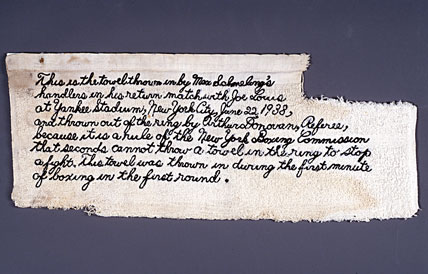As COVID-19 deaths spiked in 2020, Suzanne Firstenberg’s public art installation "In America: How could this happen…"
History Explorer Results (1131)
Related Books (0)

Grade Range:
K-12
Resource Type(s):
Artifacts, Primary Sources
Date Posted:
11/6/2008
This print shows American forces attacking the fortress palace of Chapultepec on Sept. 13th, 1847. General Winfield Scott, depicted in the lower left on a white horse, led the southern division of the U.S. Army that successfully captured Mexico City during the Mexican American War.

Grade Range:
K-12
Resource Type(s):
Reviewed Websites
Date Posted:
9/10/2008
The Western Museums Association challenges the diverse museum community of the West, empowering individuals to cultivate leadership and enable institutions to remain relevant in a dynamic world. We provide opportunities for learning and personal interaction to enhance the creative skills and enri

Grade Range:
K-12
Resource Type(s):
Artifacts
Date Posted:
9/17/2015
One of two telephones used by Alexander Graham Bell in a demonstration that took place between Boston and Salem, Massachusetts on November 26, 1876. Critical features are the iron diaphragm (seen as a black circular disc mounted on the vertical wooden support), two electromagnets (seen in white,

Grade Range:
K-12
Resource Type(s):
Artifacts
Date Posted:
4/4/2016
The portability of cellular telephones provides users with the ability to make calls from almost anywhere and Motorola was built on portability. The company made car radios in the 1930s and portable radios called walkie-talkies for the U.S. military during World War Two, and played a major role i

Grade Range:
K-12
Resource Type(s):
Lessons & Activities
Date Posted:
2/15/2017
Working with a teacher, students will recreate some of the electrical experiments originally performed by Benjamin Franklin between 1746 and 1754. These hands-on experiments highlight Franklin’s innovative contributions to science and government. Visitors will experience static electricity and

Grade Range:
K-12
Resource Type(s):
Artifacts
Date Posted:
4/16/2018
The glass ballot jar became a symbol of democratic self-government. This 1884 glass ballot jar is typical of the transparent devices used to secure paper ballots.

Grade Range:
K-12
Resource Type(s):
Artifacts, Primary Sources
Date Posted:
9/3/2020
A U.S. Border Patrol official reviews a bracero's documents while others wait in line to be processed at the Hidalgo Processing Center, Texas.

Grade Range:
K-12
Resource Type(s):
Artifacts
Date Posted:
12/30/2020
Some girls made history by simply going to school and claiming their right to belong. Minnijean Brown is one of those girls. In 1957, she and eight classmates integrated the all-white Central High School in Little Rock, Arkansas, during the civil rights movement. White students physically and verbal

Grade Range:
K-12
Resource Type(s):
Artifacts, Primary Sources
Date Posted:
2/11/2009
Heavyweight boxing champion Joe Louis (1914-1981) lost his first bout with Nazi Germany's champion Max Schmeling in 1936, but the return match was a triumph for America. This towel was thrown in by Schmeling's handlers at Yankee Stadium, New York City, June 22, 1938, where Louis pummeled his oppo

Grade Range:
K-12
Resource Type(s):
Artifacts, Primary Sources
Date Posted:
2/19/2009
Although introduced by Spanish settlers, the island's carnival celebrations, like mask making, music, and public performance, have developed into uniquely Puerto Rican traditions that also reflect the customs and sensibilities of Puerto Ricans' African ancestors. This carnival mask pictured here









